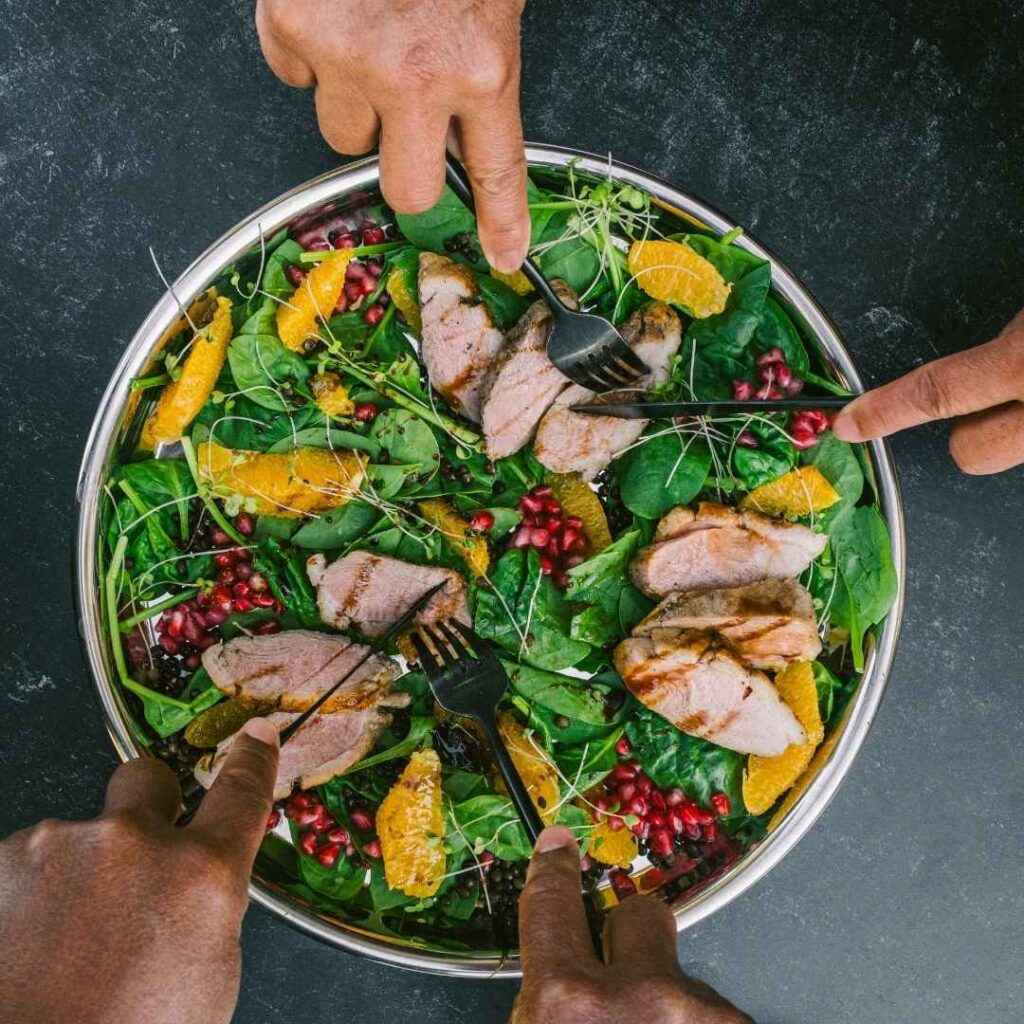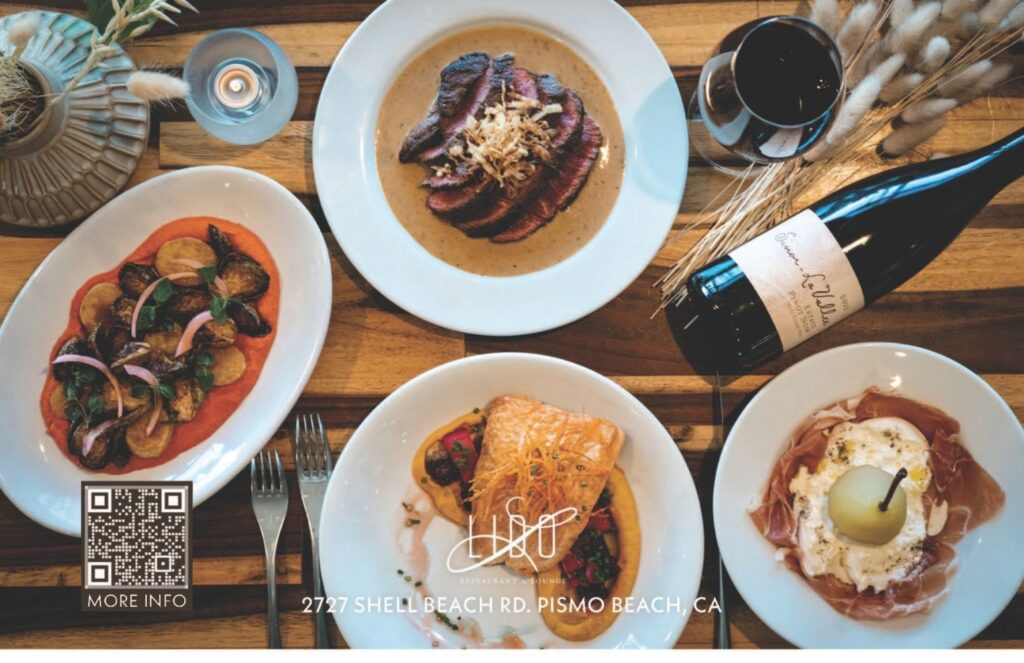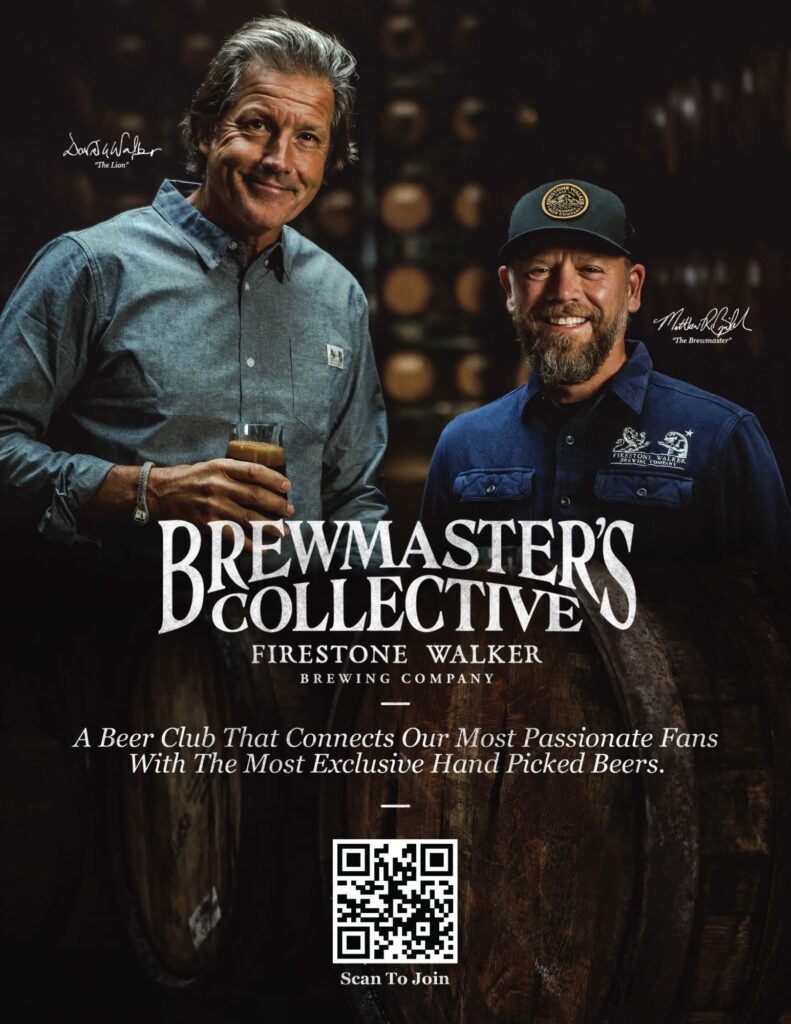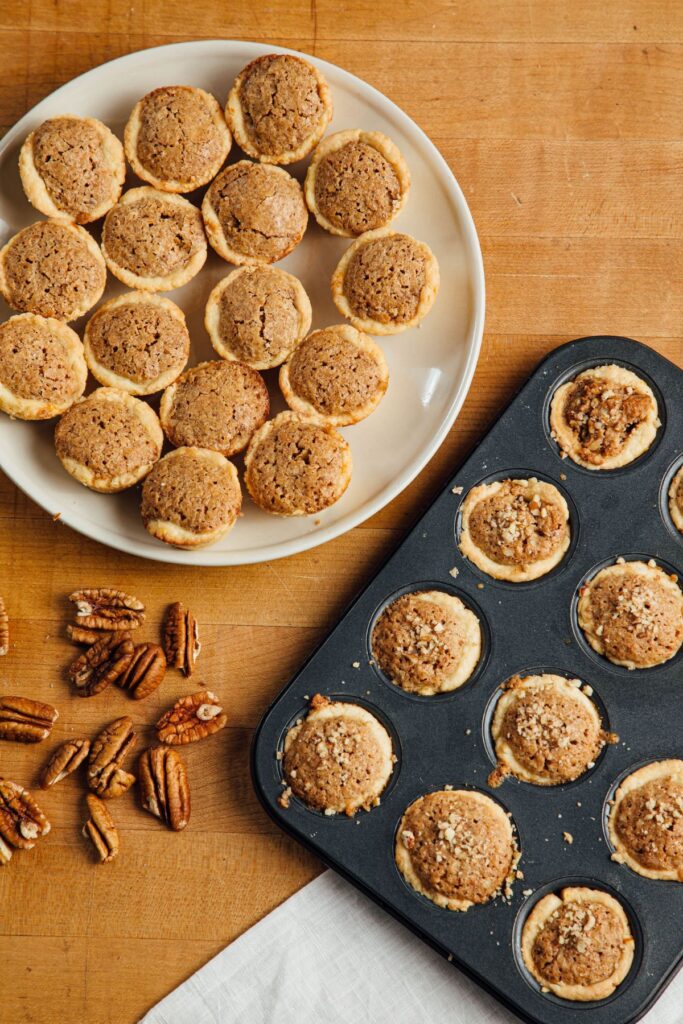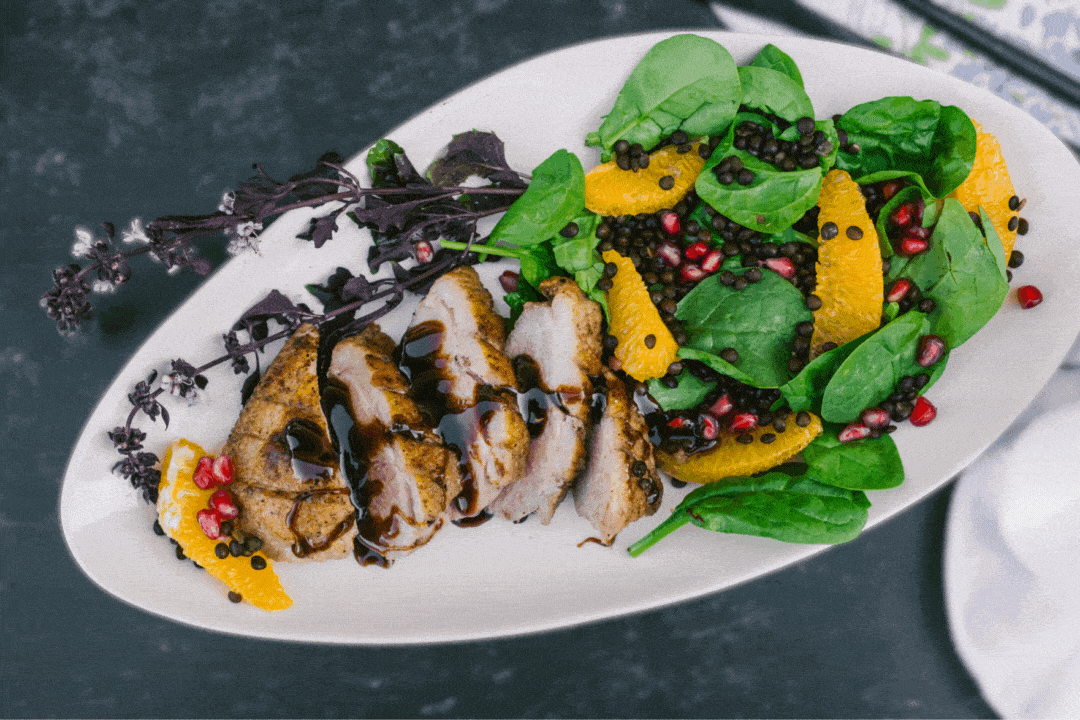

Welcome to the first Edible Magazine San Luis Obispo digital exclusive for Winter 2024. Here you’ll find the entire magazine’s stories and photos, highlighting this quarter’s theme — comfort. We encourage you to enjoy reading this on your computer, tablet, or phone with a hot chocolate in a place you find comfort. You can also access the digital edition here, with the traditional look of a magazine. We thank you for reading and hope you enjoy the stories crafted by our brilliant writers and moments captured by our skillful photographers. A traditional digital magazine that you know and love is available for viewing here.
Winter 2024 Magazine Table of Contents
PUBLISHER
Shop Talk LA, Inc.
MANAGING EDITOR
ART DIRECTOR
Jenna Hartzell
WRITERS
Aja Goare, Dustin Klemann, Maria De Lourdes Orozco Ramirez, Heidi Richter, Ashley Swartzendruber, Erica J. Thatcher, Kelly Weaver
PHOTOGRAPHERS
Richard Fusillo, Aja Goare, Dustin Klemann, Cole LoCurto, Heidi Richter, Lori Rice, Ashley Swartzendruber
DIGITAL EDITOR
Dustin Klemann
VIDEO PRODUCERS
Aja Goare, Stephen Heraldo
FOOD STYLIST
Rachel Ponce
ILLUSTRATOR
Anna Takahashi
SOCIAL MEDIA
Stephen Heraldo
COVER ART
Photographed by Richard Fusillo
SALES
Uli Billington
Food for Thought
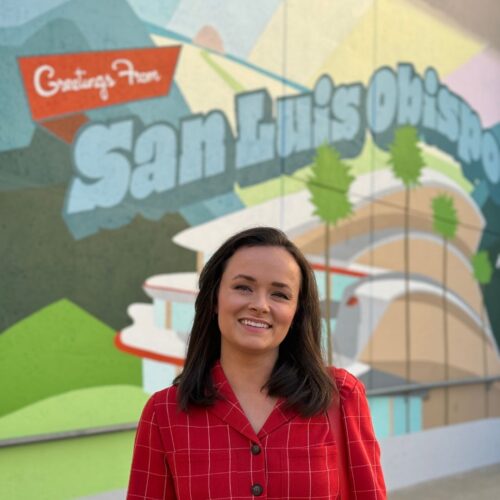
If you’re reading this right now, you are experiencing a first alongside us. This is Edible San Luis Obispo’s first ever digital issue! As we get older, we don’t experience quite as many “firsts” as in our youth, so this is a thrill for all of us at the magazine. Thanks for joining us on this virtual ride.
There aren’t any cyborgs or holograms here, but what we do have for you is a thoughtful series of videos and interactive pieces to bring our stories to life. Ironically, perhaps, this issue is called “Comfort,” and many people might argue that trying new things is exactly the opposite. But what is comforting is knowing that we have a creative team of contributors who are excited to dip their toes into new ponds to bring you something magical.
This issue, we shared creative control of our cover with you, our readers. Our Cook the Cover recipe competition brought us tasty dishes with heartfelt stories. We are excited to share the tale of our cover winner and his Christmas Duck.
Comfort takes different meaning depending on who you ask. Here, we ponder the comfort of a hearty meal (pasta, anybody?), the warm feeling of the holidays and the family recipes that get dusted off but once a year, and even the solace of exploring a loved one’s legacy after they’re gone.
That last one was especially personal, as I got to learn about my late grandmother alongside my dad and sister in Germany. We explored her heritage and got to know each other more while discovering her past over (many) plates of German dumplings and pints of beer.
For those who spend all year yearning for the fuzzy feeling of the holidays, we have some cookie recipes for the big man in the red suit, seasonal activities and a festive music playlist. And though this time of year certainly can be stressful, we sure hope all the love and creative spirit we’ve poured into this issue brings you a little bit of comfort.
Cook the Cover
Story by Aja Goare
Photography by Richard Fusillo
Videography by Stephen Heraldo and voiced by Dustin Klemann
Food styling by Chef Rachel Ponce
Shot on location at La Lomita Ranch in San Luis Obispo
Inspired by our friends at Edible San Diego and their annual Cook the Cover celebration, we put the call out to you, our readers, to be featured in the magazine – asking you to share your own beloved recipes that bring back warm memories. And wow, did you deliver. We read recipes that told family stories, dishes that embraced a go-big mentality and others that celebrated the subtleness of a quiet, cozy winter. Our team then tested the recipes, styled the food, and swapped stories with the finalists about each dish.
Here are the three cream of the crop original recipes that stood out to our editorial team, courtesy of the talented cooks who have proven to us that there is no better comfort than a home cooked dish.
Meet Our Cook the Cover Winner
The winner of Edible San Luis Obispo’s first ever Cook the Cover competition shared a holiday dish that has won his family over on three occasions without imposing on his work schedule. Unlike many who celebrate the holidays with a few days off, Father Ian Delinger prepares the meal after a marathon of church services.
Duck is considered by some a difficult dish to prepare – if the meat is under or overcooked, which can happen easily, then the dish is ruined. But Ian says his recipe is pleasantly manageable, even after a full day of work.
“The first time [I made the dish] was 2018,” says Ian. “The criteria were I have to be able to come home from three services over the course of 16 hours, including midnight mass, and prepare a dish that isn’t too laborious. Also, I’m focused on something that’s visually stunning, and was different than turkey, beef or ham.”
What he’s named his “Christmas Duck Breast over Beluga Lentils and Wilted Greens” is a family favorite, even for his brother-in-law, who happens to be a Bay Area chef. Drizzled with pomegranate glaze, the tartness pairs well with a hint of sweetness from agave syrup and a bit of citrus to add acidity.
“I actually don’t like fruit and meat because I don’t have a sweet tooth, so the tartness helps with that,” explains Ian. “But you have to have something that cuts the fat of the duck. You’ve got this lean breast meat, but also have a fat cap on it. Even if you cut the fat cap off like I do, you still need something to cut through that and it’s usually the acid. So, the tart and acid-citrus help balance the duck and also give it another dimension.”
This fatty meat can be an intimidating choice for novice and seasoned cooks, alike. But Ian has a couple tips to smooth out the process.
“If you’re not familiar with cooking duck breast and you know it’s supposed to be medium rare, my suggestion is cook it in a pan with fat side down first. Flip it over and cook longer; if you’re dividing up into minutes, cook a minute longer on the fat side than the meat side.”
While some use a thermometer to check the temperature of the meat, Ian relies on touch. He suggests using a method of pressing thumb to palm of hand (as shown in video) to determine doneness.
The key to success, he says, is practice.
“I learned this from my brother-in-law, he said never do something new on Christmas day,” he laughs. “So definitely try it some other time in December and see how it goes.”
He pairs it with locally sourced wines – but a pinot noir is the classic match-up.
“Last Christmas, we had that and more with it – we had wines from Santa Barbara County, SLO County and Sonoma County at the table for Christmas last year,” he shares.
When serving his holiday feast, Ian looks for two measures of success.
“You know you nailed it when you slice it open and it’s the perfect color. Then everything else is going to be fine. But the indicator that it’s been a good Christmas dinner together is everyone stays at the dinner table hours later,” he explains.
Once the night comes to an end, the conversation and time shared around this heartfelt meal is what truly leaves him and his guests full.
Christmas Duck Breast over Beluga Lentils and Wilted Greens

Recipe by Father Ian Delinger
INGREDIENTS
- 1 cup pomegranate syrup
- 1 cup agave syrup
- ½ cup balsamic vinegar
- 1 tablespoon freshly squeezed orange juice, from about 2 oranges
- 4 cups water
- 1 tablespoon salt
- 2 cups dry beluga lentils
- 6 duck breasts
- 20 ounces spinach
- 1 cup pomegranate seeds
- Zest from 1 orange
PREPARATION
Step 1
Prepare pomegranate sauce by placing pomegranate syrup, agave syrup, balsamic vinegar and orange juice in small saucepan. Simmer until thick and reduced by half. (This can be prepared a day ahead.)
Step 2
In large pot, bring 4 cups of water plus salt to a boil. Add beluga lentils. Cook for 8 to 10 minutes or until al dente. Drain in colander and keep warm. While lentils are cooking, in extra large skillet or two large skillets sauté duck breasts skin side down, over medium heat. Cook for 6 minutes and turn and cook for another 2 to 4 minutes until medium rare. When medium rare, duck breast should give a little when pressed with finger – not squishy (signifying underdone) or firm (overdone). Remove from heat and place duck breasts on paper towels to drain fat. Let rest for at least 5 minutes before slicing. Cut duck breasts into ½ inch slices.
Step 3
On large platter, spread spinach greens to platter edges. Spread hot lentils over spinach. Place slices of duck breast over lentils. Drizzle pomegranate sauce over dish, then sprinkle pomegranate seeds, followed by orange zest. Serve using a flat spatula and serving spoon so guests can scoop under greens, duck and lentils in one movement.
Pairing Note
This dish pairs well with many San Luis Obispo County wines, particularly Pinot Noir from the Edna Valley, Chardonnay, Albariño, or North County Zinfandel.
And meet our Cook the Cover runners up.
Oyster Chowder
Recipe by Margot Kandarian
“I developed this recipe while working for Morro Bay Oyster Company. I was the farm supervisor there for the past four years and have recently transitioned to running my own mobile oyster bar full time, Flying Colors Co. I grew up in a local farming family, so eating local for both seafood and produce is really important to me. Working on an oyster farm provided me with a bounty of oysters to use to perfect this dish. It’s a pretty flexible recipe – I’ve done it with and without leeks/fennel/celery/onions, depending on what is in season. It’s also great cooked with clams instead of oysters.”
INGREDIENTS
- 2 pounds Yukon gold potatoes
- ½ pound bacon
- 2 tablespoons butter
- 2 leeks, sliced (fennel can be substituted)
- 2 ribs celery, diced
- 1 white onion, diced
- 5 cloves garlic, minced
- 1 cup white wine
- 5 dozen fresh oysters
- 1½ cups half and half
- Salt and pepper, to taste
- Chives or parsley, for garnish
- Hot sauce
- Sourdough bread, optional
PREPARATION
Step 1
Preheat oven to 425 degrees F. Bake potatoes for about 20 minutes; potatoes should be golden brown and toasted on the outside. Let cool and then dice.
Step 2
In medium pot, cook bacon. Once cooked, remove and dice when cooled. Drain out most bacon grease from pan, leaving about 1 teaspoon of grease in pan. Add butter into remaining bacon grease and sauté leeks, celery, onion and garlic. When golden brown and soft, deglaze pan with wine. Add potatoes and stir. Allow all contents to simmer. Chowder will be thick, similar to a gravy consistency.
Step 3
While simmering, shuck 4 dozen oysters. Leave 1 dozen unshucked to be placed directly into soup, for a lovely plating effect. Save oyster liquor as oysters are being shucked. Stir half and half into chowder. Continue stirring. (Add in more water, fish stock or clam juice to get chowder to preferred consistency.) Add shucked and unshucked oysters, and oyster liquor. Let chowder continue to simmer for 10 minutes. For serving, sprinkle with bacon on top. Follow with salt, pepper, chives or parsley and hot sauce. Serve with toasted sourdough bread. (Note: Chowder is even better as leftovers once flavors have time to meld!)
Gluten Free Vegan Banana Cake with Cream Cheese Frosting and Bananas Foster Sauce
Recipe by Lydia Ross
“Living with food allergies requires some creativity and out-of-the-box cooking, but for me it’s a fun challenge to develop recipes that are delicious and beautiful. This is what brings me true joy, the memories around the kitchen table with my family, not letting severe food allergies or celiac take away from making memories and enjoying life. Being able to share recipes with others who experience food allergies or dietary restrictions is another gift. I don’t want anyone to feel left out or deprived, but instead experience the abundance and variety that life offers, making sure no one misses out on an appetizing meal or scrumptious dessert.”
INGREDIENTS
- 3 ripe bananas, mashed
- ½ cup coconut sugar
- ¼ cup maple syrup
- ½ teaspoon salt
- 1 teaspoon baking soda
- 1 tablespoon apple or white vinegar
- 2 teaspoons white vanilla flavoring
- ¼ cup oil
- ¼ cup apple sauce
- 2 teaspoons baking powder
- 2½ cups King Arthur Measure for Measure gluten free flour
For cream cheese frosting:
- ½ cup Spectrum or Nutiva shortening
- 2½ cups powdered sugar
- 1 tablespoon Arrowroot starch
- 4 ounces dairy free cream cheese (Violife or Trade Joe’s brands preferred), room temperature
- ¼ teaspoon salt
- 2 teaspoons white vanilla flavoring
- 1–2 tablespoons dairy free milk to thin, if needed
For bananas foster sauce:
- 1 tablespoon water
- ⅔ cup light brown sugar
- ¼ cup vegan butter
- 2 teaspoons rum
- 2 tablespoons dairy free milk
- Pinch of salt
PREPARATION
Step 1
Preheat oven to 350 degrees F. In large mixing bowl add bananas, coconut sugar and maple syrup. Mix with wooden spoon. Add salt, baking soda and vinegar. Mix well. Add vanilla, oil, apple sauce and baking powder. Mix again. Fold in gluten free flour. Pour into a greased 9-inch square by 2-inch-deep cake pan. Bake for 30 minutes. Check for doneness by inserting a toothpick: when cake is done, toothpick should come out clean. Remove from oven. Let cake cool in pan, then remove. Finish cooling on a wire rack.
Step 2
To make frosting, combine all frosting ingredients. Using a hand mixer or stand mixer, cream all ingredients together to preferred frosting consistency. Add dairy free milk to thin if needed. Once cake is cooled, frost.
Step 3
To make bananas foster sauce, in a saucepan over medium heat combine water, brown sugar and vegan butter. Stir until melted. Add rum and dairy free milk. Whisk. Bring to a boil and continue to cook for additional 2 minutes. Remove from heat. When cooled, slice cake and drizzle sauce over.
Santa Claus is Coming to Town
Santa Claus is Coming to Town
Perspective: Rooted in Resilience
Perspective by Maria De Lourdes Orozco Ramirez
In this Perspective piece, Maria De Lourdes Orozco Ramirez, 26, retraces her childhood in Mexico and explores her journey to working directly with underserved and socially disadvantaged farmers in SLO County.
I’m the daughter of farm workers, and the lineage of farmers in my family goes way back. You could say it’s in my DNA — the love for farming has been passed down through generations. Working with San Luis Obispo County farmers to help them access resources that support their farms was a natural career choice for me.
Born in a small rancho near Guadalajara in the state of Jalisco, I was introduced to rural life at an early age. My family, both past and present, has raised livestock, grown maize and practiced subsistence farming. One of my earliest memories is the short walk to my grandparents’ farm, where we gathered fresh vegetables, dairy and honey to enjoy. Our lives were deeply intertwined with the land and the bounty it provided.
This connection to the land is something my family has carried through generations. My grandfather, now 101 years old, still shares stories of his time working in California’s Central Valley under the Bracero Program. Between 1942 and 1964, this program employed over five million Mexican farm and railroad workers, and the money he earned helped him buy land back in Mexico for his own farm. Listening to his stories gave me an early understanding of the harsh realities of farm labor, but also the resilience and perseverance that farming requires. His experience serves as a powerful link between past and present, showing how generations of farm workers like him have shaped agriculture in the Americas.
When I was four, my family moved to Los Angeles. The move was a culture shock — life in a bustling city was vastly different from the quiet, rural, but close-knit rancho we had known. My parents didn’t speak English, which made adjusting to our new life even harder. For years, my father worked as a horse trainer at Santa Anita Race Track, but eventually, we relocated to Shandon and then Atascadero, seeking a lifestyle more in tune with our roots. Despite the move, we faced challenges, especially as my parents navigated the labor sector in a country where they didn’t speak the language. My siblings and I often had to translate for them, a responsibility that shaped me in profound ways.
As I grew older and began considering my own career, I knew I wanted to do something related to food. Food has always been central to my life. Initially, I thought I might become a chef, but I realized I could make a broader impact by addressing the barriers faced by BIPOC (Black, Indigenous, People of Color) farmers.

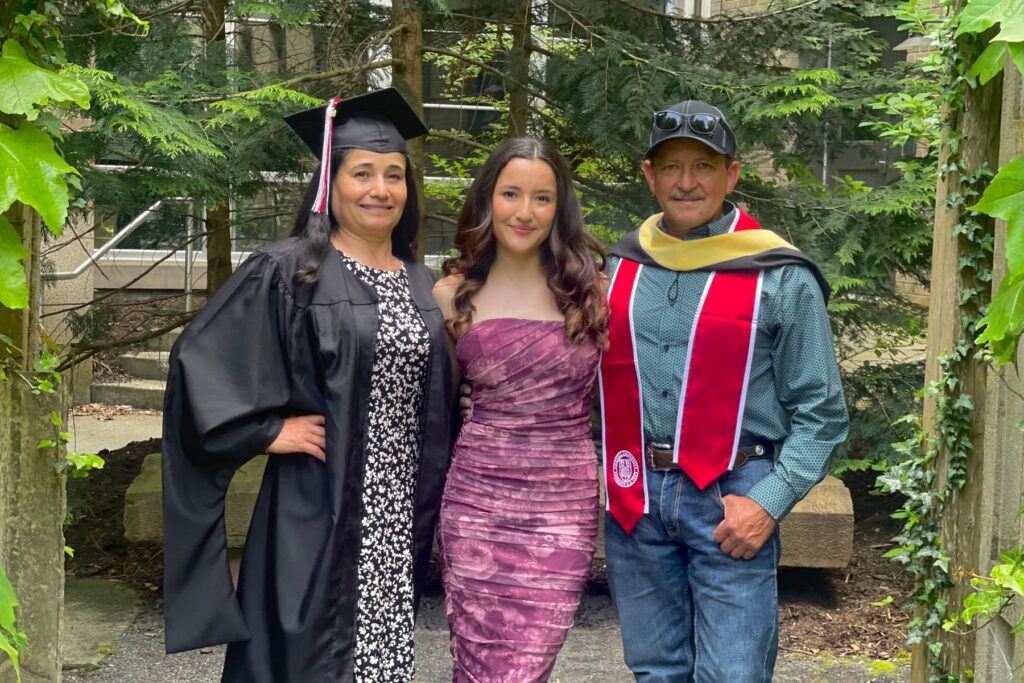
My educational journey took me to UC Davis, where I earned a bachelor’s degree in Sustainable Agriculture and Food Systems, and later to Cornell University, where I received a master’s degree in Global Development. These experiences deepened my commitment to working with underserved and socially disadvantaged farmers.
During my time as a bilingual Community Educator for the UC Small Farms Network, I supported farmers dealing with the challenges of extreme weather and growing non-commodity specialty crops. I saw firsthand the struggles many farmers experience, particularly those who are undocumented and don’t speak English. It became clear to me that the lack of Spanish-speaking community educators and technical assistance providers meant many Latino farmers were missing out on opportunities for support.
Farming is time-consuming, and small and diversified farmers often don’t have the resources to navigate the complex systems for grants and financial assistance. However, there are numerous financial and educational opportunities available to them. My goal is to connect these farmers with the resources they need and help them prepare for unforeseen challenges, like natural disasters, so they can keep their farms going for generations.
Currently, I am the Education and Mentorship Coordinator at the UC Organic Agriculture Institute, where I help facilitate the TOPP Mentorship and Demonstration Network program. These initiatives compensate experienced organic farmers who serve as mentors to aspiring organic farmers or those in transition. Recognizing the wealth of knowledge that farmers hold, these programs create a network of farmer-to-farmer knowledge exchange that is critical to maintaining sustainable practices and promoting environmental stewardship.

It’s vital that small, diversified family farms exist and thrive—they are the backbone of our local economy. These farmers provide us with culturally relevant crops, implement environmentally friendly practices, and contribute to the ecology of our food system. Many of the growers I work with sell at multiple farmers markets across California, and they know their customers. They listen to them and understand what they need and want to put on their tables.
I have immense respect for the work these small BIPOC farmers are doing. I know it’s not easy. Every time I see them with their families, and the children are translating for them, I see myself, and I’m reminded why I do this work. It’s about opportunity. Helping these farmers not only strengthens our food system but also makes our communities and economy more resilient.
The Warmth of Le Petit Soleil
French styled bed and breakfast offers European flavor and flair.
Story by Aja Goare
Photography by Blake Bronstad
The French term mise en place – “putting in place”– refers to the preparation of ingredients for cooking a meal. Just as a Le Cordon Blue trained chef has chopped herbs, cubed butter and rinsed vegetables at the ready, the staff at Le Petit Soleil leaves no detail unfinished before welcoming in guests to its San Luis Obispo bed-and-breakfast.
Inherited from the Connor Family after 20 years of ownership, Owners Brandon Ristraino and Misty Orman Ristaino are committed to upholding the European charm and comfort for which Le Petit Soleil is known. “We stayed at this hotel in 2017 during a little mid-week getaway,” recalls Brandon. “We briefly met the owners and had no idea we’d one day own the property. It was on our radar, but ultimately, we found out the sellers were interested in selling and wanted to sell to someone with similar hospitality views – we are very passionate about hospitality and relayed that we’d keep up what they worked hard to build.”
What previous proprietors John and Diane Connor had built over the last two decades is a 17-room Parisian style boutique property complete with a garden courtyard and dining area. Constructed in 1952, the Monterey Street B&B features a patio reminiscent of the French Riviera, and a central dining and cocktail area with navy velvet banquettes, wall-papered ceilings and French doors that let in natural light.
Guests enjoy complimentary breakfast from a rotating menu that might include house-made favorites from blueberry pancakes to seasonal veggie frittatas, fresh baked pastries, croissants from Back Porch Bakery, farmer’s market produce and fruits, Cal Poly produced cheese, and pour over coffee from locally sourced coffee beans by Coastal Coffee Collective. A daily aperitif hour in the common area invites guests to enjoy a complimentary cocktail alongside Cal Poly cheeses, Alle-Pia cured meats, savory house made baked goods, seasonal fruit, house-made spicy nut mix, and local, as well as French, wines selected by Master Sommelier Lenka Davis.
“We inherited a strong food program here,” says Brandon. “John and Diane are excellent chefs and prepared the breakfasts over the years. The team that we inherited and work with today continue that tradition. We brought on Ryan and Tyler, who are Michelin gourmand chefs and both trained in France. They’re making small tweaks to the program to improve an already great product.”
Next door to Le Petit Soleil, Brandon and Misty are jump starting the recently shuttered Splash Café to serve as an extension of the bed and breakfast.
“We’re adding four suites to Splash upstairs, and downstairs will be a cocktail bar and restaurant,” Brandon shares, noting that the renovations should be complete in early 2025. “Ramon Velasquez is a bib gourmand Michelin chef from Guadalajara who specializes in Mexican cuisine. He’s got a specific food menu in mind for [the former] Splash café.” And Misty, with her experience bartending, will lead the creation of the cocktail menu.
Their vision for the hotel comes from a shared love of traveling the world. “We do as much travel as we can to get inspired to eat and drink and get to know other cultures,” he says.
Having spent so much time in hotels themselves, the couple was emboldened to embark on running their own line of hotels under the Good Lion Hospitality Group. Since 2014, they have opened and operated a line of hotels from Santa Barbara to San Luis Obispo, including five bars and restaurants in Santa Barbara and Ventura. But getting into the San Luis Obispo market was a challenge, and an expensive one at that.
“Misty and I met in LA – I was running cocktail bars and restaurants and she was, and is, in the entertainment industry as a hand model,” Brandon explains. “We relied on her income from these modeling sessions.”
Today, those hands help adorn the property with thoughtful touches that make the space comfy for guests from near and far. A mini bar in each room pairs well with curated snacks for purchase, and a walk-in shower is made even more luxurious with Sangre de Fruta amenities.
“The best places we’ve visited in our travels are the ones that pay attention to small details,” says Brandon. “That’s what we’re trying to do here, let the details bring it to life.”
Cabinets of Curiosity

Seed libraries across SLO County invite garden exploration and fun.
Story and Photography by Erica J. Thatcher
Remember those old wooden card catalog cabinets from the school library? Well, they’re back –and with a lot more charm. Public libraries across the country are repurposing them as seed libraries that hold small packets of seeds for gardening enthusiasts to sample, at no cost.
Seed libraries can be found locally in San Luis Obispo County, too. Nine of the 14 County of San Luis Obispo Public Libraries offer a selection of seeds for organic herbs, seasonal vegetables, flowers and native plants.
It’s way more fun to pull out the wooden catalog drawers these days. Instead of flipping through faded subject cards with mysterious library lingo, visitors can thumb through small gold paper packets of seeds that inspire imagination and curiosity. Johnny Jump Ups, California poppies, calendula, marjoram, Love in the Mist — for those unsure how to grow what’s inside the envelope, don’t worry. Each packet is labeled with a photo and growing instructions.
Look for the quaint vintage cabinets in Arroyo Grande, Atascadero, Los Osos, Morro Bay, Nipomo, Santa Margarita, Shell Beach, Shandon and San Luis Obispo libraries. Borrowers are not expected to exchange seeds from their own gardens. Like other library offerings, the seed library program is intended to be a risk-free way to try something new.


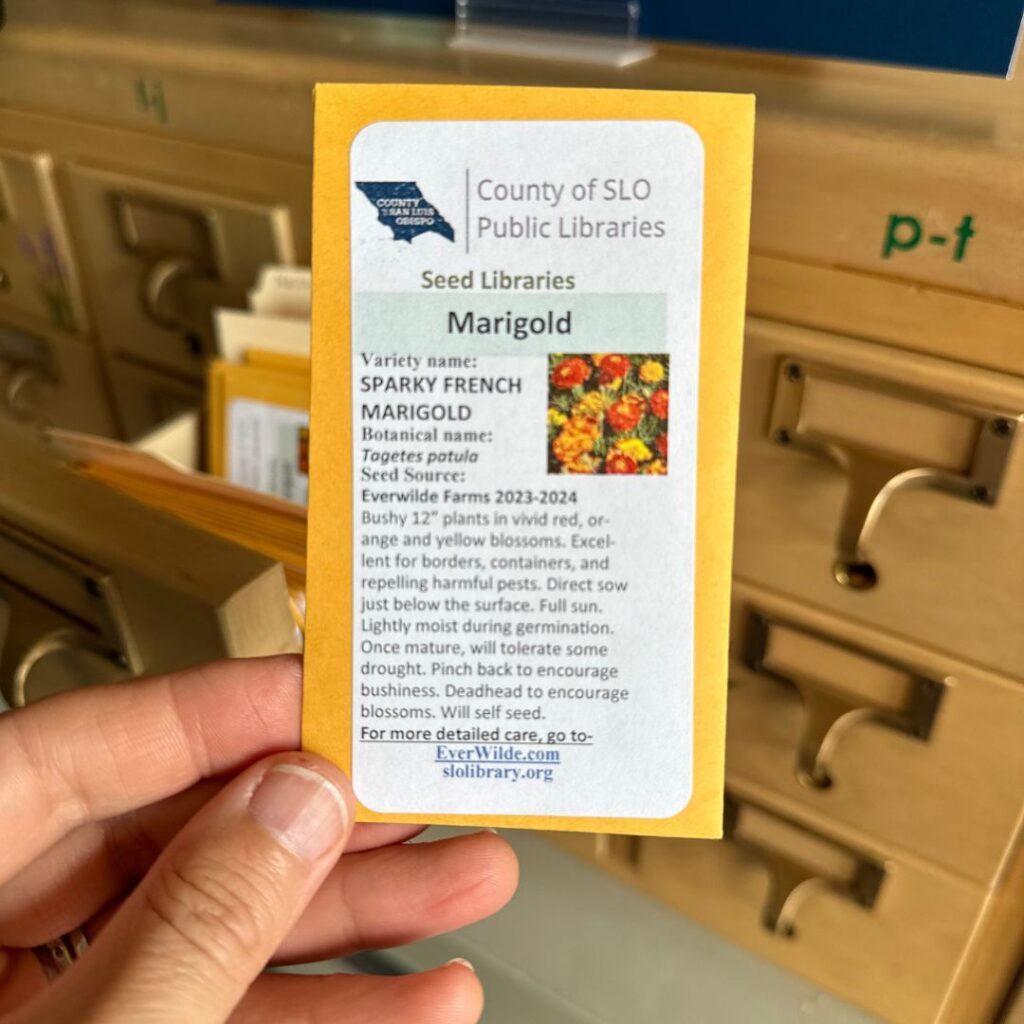

Antoinette Padgett manages the seed library at the Los Osos Library; she has a specific approach to helping curious people try their hand at gardening. “I personally try to push the native plant seeds,” she explains. “Getting beneficial insects and animals into gardens is so important.” She also likes to guide people to the native plants garden right outside the front door of the library. “You can see the seed library in action there,” she says. The Los Osos Valley Garden Club manages the garden that attracts plenty of butterflies and bees.
The seed libraries program started in 2018, but Antoinette says the pandemic years really boosted participation at all locations. “People had time to garden. It was hard to keep the cabinets stocked,” she recalls.
The collections prioritize organic and heirloom seeds bought from a certified vendor. Libraries once operated a true exchange model where people contributed their saved seeds, but it was decided it was better to buy seeds to make sure they were organic, and not duds.
Chelsea Cutler stocks the seed library at the San Luis Obispo Library. “Every library does it a little differently, but we all use a checkout sheet.” The libraries report between fifty and one hundred people each month using the seeds.
Seed libraries give people the opportunity to be part of a resilient and sustainable community, explains San Luis Obispo Library’s Dorothy Gruett, who leads a countywide library sustainability committee. “The seed libraries incorporate the teachable concepts of food sustainability, food security, the importance of native plantings and the wellness of the planet,” she says. The American Library Association identified sustainability as a core value of librarianship in 2019.
Dorothy thinks the seed libraries and adjacent events are among the most popular ongoing programs that the library offers. Hundreds of people checked out seeds and attended gardening events at libraries across San Luis Obispo County in 2023. The Morro Bay Library alone had over 550 participants, including a group of 4-H club members who sorted and packaged seeds for the library as part of a volunteer project.
It’s fun to see kids get in on the action, says Dorothy, adding: “Seeds fuel family creativity and learning by doing. It can be used to demo math, poetry, journaling, history and science.”


Chelsea has also witnessed generational connections form over seeds. “A grandmother reported that she and her granddaughter transplanted the seedlings that they grew from our seeds. It was their bonding time,” she shares.
Santa Margarita Library Manager Tracey Montelongo has also received positive feedback about the seeds. “One of our patrons has grown a spectacular garden from our seeds. He’s very excited about it,” she says, noting that he shared with her photos of giant basil and pepper plants, corn and California poppies.
Together, Tracey and Dorothy launched a thriving community garden at the Shandon Library using seeds from the seed libraries, and inspired kids and adults to pitch in at a grand opening gardening event. For those feeling inspired, the folks at the libraries hope community members also try their other gardening resources.
The Shandon Library lends tools ranging from shovels and wheelbarrows, to electric trimmers and hedgers. Libraries regularly host lectures from the Master Gardeners of SLO County and local nurseries with expert advice about gardening with natives, pollinators, succulents and pest management.
Seed and plant swap events at the libraries are also popular with gardening enthusiasts. Hundreds of people shared cuttings, seeds and plants at Los Osos Library’s swap events in June and July of 2024. “We never have any plants left at the end of the day,” says Antoinette. And for more garden inspiration, a library card also opens the door to free passes to the San Luis Obispo Botanical Garden.
Dorothy’s not surprised the enthusiasm continues to grow – playing in the dirt is just plain fun. “It’s a feast for the senses: the feel of the soil, the smell of the flowers, the beauty of new life,” she explains.
And, please, don’t forget the books: A library card grants access to hundreds of recently published gardening guides. Those pursuing a garden-to-table growing system can enjoy the bounty using ideas from the library’s collection of beautiful cookbooks. Visit the library’s website to browse and reserve books to pick up at your favorite library.
No card catalog search required.
A library card is free. Visit SLOLibrary.org to browse gardening books and for more information about membership, locations and gardening events.
Finding Comfort Abroad
Story, Photography & Video by Aja Goare
In this first-person piece written by Edible San Luis Obispo Managing Editor Aja Goare, she shares how her visit to Germany and the food she ate there helped preserve the memory of her late grandmother.
On a cobblestoned street surrounded by vibrant green forests, halfway around the world, I looked up at the duplex in south Germany where my great grandmother spent her childhood. Years before I was born, my grandmother – Dorothy Goare – had visited this very spot to learn about her mother’s early life. And now, five months after Dorothy’s death, I was doing the same alongside my father and sister.
“The great thing was being able to do away with the myths you have in your head – what must that be like – and of course my grandmother is the one that left and came over on the big boat to find a new way in America,” says my dad, James, reflecting on the trip. “It’s one thing to think about it and the terms you can make up in your head; it’s another thing to stand in the spots and take the pictures and talk to people that were there and knew. That’s a whole different thing.”
In 1912, my then 24-year-old great grandmother Pauline decided to leave her small Bavarian town of Heidenheim for America. Just 10 days after the infamous Titanic sank, she boarded the S.S. President Grant with her half-sister and took a two-week-long voyage to New York. As a newspaper account of the trip explains, she only “brought her clothes and a German Bible.” Upon her arrival, Pauline didn’t speak English and had few connections until she met and married her husband in 1920.
Among the few physical artifacts that remain from Pauline’s time on earth are photos, a newspaper clipping about her nautical journey, and a menu from the boat that included “calf’s head à la Tertolliére” and sardines. She died when my father was just a boy, but he holds dear those young memories of his grandmother.
“It felt like a time capsule. The town felt exactly as it would have if our grandma was still there. It didn’t seem like it had changed much but in the most beautiful way.”
Jasmine Goare
Among the few physical artifacts that remain from Pauline’s time on earth are photos, a newspaper clipping about her nautical journey, and a menu from the boat that included “calf’s head à la Tertolliére” and sardines. She died when my father was just a boy, but he holds dear those young memories of his grandmother.
When anyone we love passes away, we find ourselves clinging to their worldly objects – a sweater, rings or watches, a keepsake – for a sense of comfort. My grandma Dorothy was a private woman who kept a lot of her memories behind lock and key in her mind. In her absence, there aren’t many family stories or heirlooms to hold on to. But on our trip to Germany, a meeting with a cousin we’d never before met presented us a trove of photos from the lives of my grandmother and great grandmother, long before us.
“That was crazy, especially because there were photos of dad as a baby that I didn’t know existed and he has a really small amount of pictures and memories,” says my sister, Jasmine. “Seeing that was really special, because it was history I didn’t know about and just seeing new things – I’m very sentimental.”
Swapping stories with our German relative over a plate of spaetzle, overlooking the city of Heidenheim, we three Americans relished every account. That includes one where Pauline, who was already 76 by the time my father was born, stole the show at her sister’s bridal shower by appearing in a flashy red dress. “No way, Pauline did that?!” my father asked our cousin, Jochen, in disbelief. “She did, she did,” Jochen said with a laugh in between bites of his beef rouladen, a traditional German dish featuring long, thin strips of meat slathered with mustard and filled with bacon, onions and pickles. Digging into my semmelknödel – a tender dumpling made from stale bread, milk, eggs, onion and parsley, soaking in a rich gravy – I glanced up at the Helenstein Castle that stood before us and wondered if my great grandmother had once shared this same view.


After pouring over photos and swapping stories, we tucked in for the night at our rental, exhausted from the travel and time change but exhilarated by all that we’d just learned and the town we’d just explored.
“It felt like a time capsule,” recalls Jasmine. “The town felt exactly as it would have if our grandma was still there. It didn’t seem like it had changed much but in the most beautiful way.”
The next morning, Jasmine and I wandered the hilly, winding streets of Heidenheim and landed at a bakery where we ordered coffee and an assortment of pastries. With only the soft sound of mist landing on vines, I bit into the slice of cheesecake I’d selected for breakfast. Dense and creamy like a slab of brie cheese, it was the best four dollars I’d ever spent. My sister devoured her monkey bread and we briefly questioned if we should turn around and march back in for seconds, before ultimately heading back to wake my dad.
We met with Jochen at a local senior living center. There, we met one of our great grandmother’s first cousins, Annalise. At 94, Annalise is living with dementia but still clings to some sacred memories. We found her in a wood-armed chair, draped in natural light inside the foyer.
“Hallo,” she greeted us with a toothy smile.
“This is my grandmother,” Jochen told us, as he introduced us to Annalise in her native German.


Jochen revealed the box of black and white family photos to his grandmother and for the next 90 minutes, we shared laughs and stories, using Jochen as a translator. Though some faces eluded her memory, Annalise recounted interactions with our grandmother and great grandmother with bright eyes and a warm smile. “She looks like Pauline,” my dad whispered to me.
At the end of the visit, we embraced one another like the long-lost family we are. A few photos captured the moment, which I’m told still resides in Annalise’s memory. “You must have made quite the impression on her,” Jochen said to me days later in text.
These shared moments consumed our conversation over the next few days and well after the trip ended. At a beer garden in Berlin, we recounted the time spent with Jochen eating ice cream and wandering the streets, happening upon the golden plaque that memorializes his paternal grandmother who was murdered by the Nazis. “To think [the Holocaust] happened 20 years after Pauline left, she must have been so worried about her family back at home,” my dad thought out loud. It was a lot to unpack.
Despite these two women in our family being gone from our lives, we felt so close to them sitting together around the table and sharing what we imagined were some of their favorite foods. We couldn’t help but feel grateful for the trail of breadcrumbs they left behind that led us to this place and to meet relatives who could give us a sense of communion.
“There are two different lives going on in two very faraway places and they intersect with a few people. It’s funny that they knew our lives and we knew some of theirs,” says James. “When you get together with people that far away, you realize people are people and friends are friends and even though they may talk differently, even though they’re very different people than us – they’re German and have different sounds to their languages, people are people.”

Fill the Fridge
On location at Farm Blanc Et Rouge
in Paso Robles
Photography by Lori Rice
The holidays are a joyous – albeit stressful – time of year. Prepping the fridge with intention saves hours of stress, extra shopping trips and unnecessary food waste. And filling it with local ingredients makes every meal something special.
-
San Luis Obispo Farm Supply Farmers Market
Cauliflower, carrots, strawberries, cabbage from Velasquez Farms
Winter squash, Haas avocados, Eureka lemons from Dragon Spring Farm
Red lettuce, romaine lettuce, leeks from MG Farms
Fire roasted salsa, roasted red pepper hummus, pesto garlic spread by Viva Mexico Foods
Organic mandarin oranges, blood oranges, Valencia oranges, Oro Blanco grapefruit from Schletewitz Family Farms
Tuesdays 2:30pm – 5pm
224 Tank Farm Rd, San Luis Obispo
farmsupplyfarmersmarket.com I @farmsupplyfarmersmarket -
Natural milk by Rosa Brothers Milk Company
Dairy farmed in Kings County
rosabrothers.com I @ rosabrothers
-
Pasture-raised eggs from
MJ Family FarmsRegeneratively farmed in Creston
mjfamilyfarms.com I @mjfamilyfarms -
Raw and delicious cold pressed juice by
RAD JuiceProduced in San Luis Obispo
radjuices.com I @radjuices -
Living salad greens from Zeste Farms
Vertically farmed in Paso Robles
zestefarms.com I @zestefarms -
International cuisine prepped meals by
Myndful MealsPrepared in San Luis Obispo
myndfulmeals.com I @myndful_meals


Food Gifts
From the book Food Gifts by food stylist and best-selling author Elle Simone Scott, here, a selection of irresistible recipes for crafting personalized presents.
“I grew up in a food-gifting household. My family has been potlucking for as long as I can remember. Even though I was young, I fully understood that “bringing a dish” to someone’s home was vitally important and deeply traditional. So much intentionality went into the planning and preparation of the dishes, and even more so into how they were presented.”
In Food & Love,
Elle
Cinnamon-Ginger Spiced Nuts
Makes about 3 cups
INGREDIENTS
- ⅔ cup superfine sugar
- 2 teaspoons ground cinnamon
- 1 teaspoon ground ginger
- 1 teaspoon ground coriander
- 1 large egg white
- 1 tablespoon water
- 1 teaspoon table salt
- 1 pound raw whole almonds, cashews, walnuts and/or shelled pistachios
PREPARATION
Step 1
Adjust oven rack to middle position and heat to 275 degrees F. Line rimmed baking sheet with parchment paper. Mix sugar, cinnamon, ginger and coriander in small bowl.
Step 2
Whisk egg white, water and salt in large bowl. Add nuts. Toss to coat. Sprinkle sugar mixture over nuts, toss to coat, then spread evenly over prepared sheet. Bake until nuts are dry and crisp, about 50 minutes, stirring occasionally. Let cool completely on sheet, about 30 minutes. Break nuts apart.
HOW I GIFT THIS
Packaging These look great in a glass jar with a clip top lid or packed into decorative paper bags or nut cones. You can even package them in a repurposed glass or plastic supermarket nut container.
Storage The spiced nuts can be stored at room temperature for about 3 weeks.
Make It A Duo Pair nuts with a wheel of Brie or with the spices used in the nut mix.




Smoked Trout Pâté
Makes 2 cups
INGREDIENTS
- 8 ounces smoked trout
- 4 ounces cream cheese, cut into 4 pieces and softened
- ¼ cup sour cream
- 2 tablespoons mayonnaise
- 1 scallion, sliced thin
- 4 teaspoons minced jalapeño chile
- 4 teaspoons lemon juice
- 1 tablespoon prepared horseradish
- ¾ teaspoon pepper
- ½ teaspoon Tabasco sauce
- ¼ teaspoon table salt
PREPARATION
Using hands, finely shred trout in a medium bowl, discarding skin and bones. Add cream cheese, sour cream, mayonnaise, scallion, jalapeno, lemon juice, horseradish, pepper, Tabasco and salt. Stir and mash vigorously with fork until thoroughly combined. Set aside for 30 minutes to allow flavors to blend. Transfer to 2-cup container.
HOW I GIFT THIS
Packaging This packages well in an airtight, sturdy deli container or a Weck-style canning jar.
Storage The pâté can be refrigerated for about 3 days; bring to room temperature before serving.
Make It A Duo Pair with sturdy crackers or a tin of smoked trout.
Make It A Trio Combine with bagels and cream cheese.
Make It A Basket Put together an elegant snack basket with the pâté, bagel chips, assorted tinned seafood, a bottle of vino or palo cortado sherry and a nice spreading knife.
Ginger Syrup
Makes 8 ounces
INGREDIENTS
- 8 ounces fresh ginger, unpeeled, chopped coarse
- ¾ cup sugar
- 5 ounces water
- ½ teaspoon ground ginger
- 2 teaspoons lemon juice
PREPARATION
Step 1
Process fresh ginger in food processor until finely chopped, about 30 seconds, scraping down sides of bowl as needed.
Step 2
Heat sugar and water in small saucepan over medium heat, whisking often, until sugar has dissolved, about 5 minutes; do not boil. Off heat, stir in chopped ginger and ground ginger and let cool to room temperature, about 30 minutes. Cover and refrigerate at least 12 hours or up to 24 hours.
Step 3
Set fine-mesh strainer over medium bowl and line with triple layer of cheesecloth that overhangs edges. Transfer ginger mixture to prepared strainer and let drain until liquid no longer runs freely, about 10 minutes. Pull edges of cheesecloth together to form pouch, then firmly squeeze pouch to extract as much syrup from pulp as possible; discard pulp. Stir in lemon juice.
HOW I GIFT THIS
Packaging This is sticky, so store in a leakproof bottle or jar with a tight-fitting lid.
Storage The syrup can be refrigerated for about 1 month.
Big-Batch It This recipe is easily scaled up.
Make It A Duo Pair with a bottle of black rum or a chai tea blend.
Add To A Basket Put together a cocktail basket with the syrup, vodka, crystallized ginger, limes, a mint bouquet, a jigger and a pair of Moscow mule mugs.
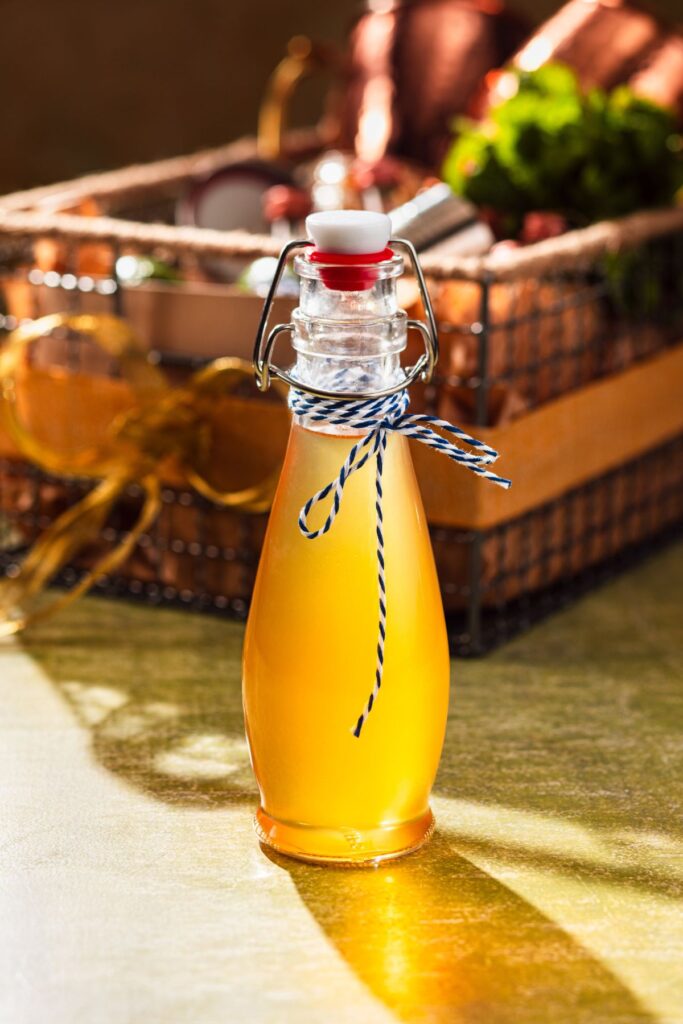

‘Tis the Season for Cookies
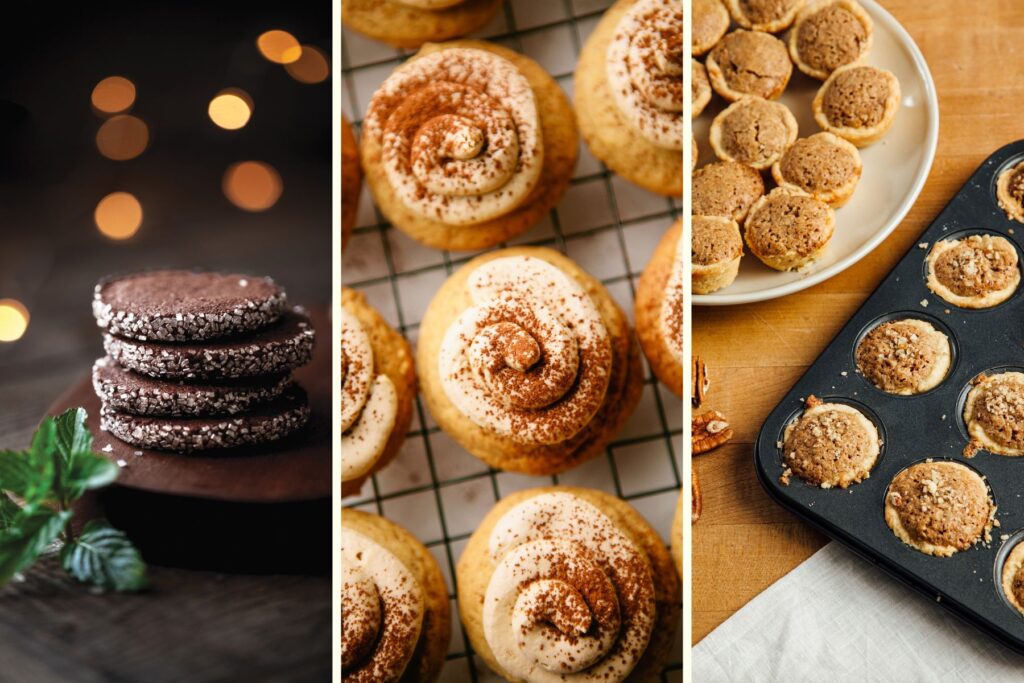
Cookies — the quintessential holiday treat. We gathered some tasty recipes from Edible publications across North America to kick off the cookie swap season. You’ll find us snacking on these with our morning coffee, or we love them as an after-dinner delight.
Mint Chocolate Icebox Cookies
Reprinted from Edible Vancouver Island
Recipe and Photography by Heidi Richter
Makes 40 cookies
INGREDIENTS
- 1¾ cups all-purpose flour
- ⅔ cup Dutch process cocoa powder
- ½ teaspoon baking powder
- ½ teaspoon salt
- 1 cup granulated sugar
- 1 cup packed fresh mint leaves, washed and dried
- ¾ cup unsalted butter, softened
- 1 large egg
- 1 teaspoon vanilla extract
- Granulated sugar for rolling
PREPARATION
Step 1
In medium bowl sift together flour, cocoa powder, baking powder and salt. Set aside. Add granulated sugar and mint leaves to food processor and blend until mint is finely chopped and sugar turns a green hue. In large bowl, beat together butter and mint sugar until light and fluffy. Beat in egg and vanilla extract until combined. Add flour mixture to butter mixture and beat on low speed until dough comes together and no flour streaks remain.
Step 2
Turn out dough onto a large piece of parchment paper. Using hands, shape and roll dough into smooth cylinder shape, approximately 2 inches in diameter and 14 inches long. Roll dough tightly in parchment, making sure to maintain shape, then twist ends like a candy wrapper. Place in refrigerator for minimum 2 hours or overnight. After dough has chilled, preheat oven to 350 degrees F and line a large baking sheet with parchment paper. Set aside.
Step 3
On large cutting board, unwrap dough and sprinkle granulated sugar (for rolling) on parchment wrapper, then roll dough in sugar to coat evenly. Slice dough into rounds a little wider than ¼ inch. Place rounds on prepared baking tray about one inch apart. Gently reshape any rounds if needed. Bake in preheated oven for 12–14 minutes or until centers have some resistance when lightly pressed. Remove from oven and transfer to wire rack to cool completely.
Orange Maple Pecan Tassies
Reprinted from Edible Northeast Florida
Recipe by Kelly Weaver
Photography by Cole LoCurto
Makes 36 cookies
INGREDIENTS
For the crust:
- 1 cup butter, softened
- 6 ounces cream cheese, softened
- 2 cups all-purpose flour
- ⅛ teaspoon orange blossom water
- Zest of 2 oranges
- ¼ teaspoon salt
- 1 teaspoon vanilla
For the filling:
- 2 medium eggs, room temperature
- 1½ cups brown sugar
- 2 tablespoons butter, softened
- 1 tablespoon maple extract
- 1 teaspoon cinnamon
- ⅛ teaspoon orange blossom water
- Zest of 1 orange
- teaspoon salt
- 1 teaspoon vanilla
- 1¼ cups pecans, finely chopped, reserving ¼ cup for topping
PREPARATION
Step 1
To make crust, combine butter and cream cheese. Follow with adding remaining crust ingredients. Work mixture with hands until it forms a shaggy dough. Mound onto plastic wrap, form into a circle, seal and place in refrigerator to chill.
Step 2
To make filling, beat eggs with brown sugar until thick and foamy. Add butter and mix until incorporated. Stir in remaining filling ingredients.
Step 3
To assemble cookies, spray mini muffin pan with nonstick spray, or use silicone pan. Preheat oven to 325 degrees F. Roll crust dough out onto lightly floured surface until approximately ¾-inch thick. Cut dough into approximately 1½ x 1-inch squares, about the size of a large postage stamp – it doesn’t have to be exact but all cookie bases should be similar in size. Roll each piece into a ball and place into mini muffin pan. With fingers create a cup shape, making sure dough goes all the way up sides. Place approximately one teaspoon of filling into each cookie base, taking care not to overfill. Bake for 10 minutes, then rotate pans. Sprinkle reserved pecans on top of each cookie. Bake about 15 minutes more until cookie crust is golden brown. After baking, allow to cool in pan five more minutes. Carefully remove from pan to wire rack and continue cooling. Store at room temperature.
Tiramisu Cookies
Reprinted from Edible Michiana
Recipe and Photography by Ashley Swartzendruber
Makes 32 cookies
INGREDIENTS
- 2¼ cups all-purpose flour
- 1 teaspoon baking powder
- ½ teaspoon baking soda
- 1 teaspoon kosher salt
- 1 tablespoon instant espresso powder
- 1 cup unsalted butter, room temperature
- ½ cup granulated sugar
- ½ cup brown sugar
- 2 large eggs, room temperature
- 2 tablespoons Kahlúa coffee liqueur
For the mascarpone frosting:
- 8 ounces mascarpone cheese, chilled
- 1 cup powdered sugar
- 2 teaspoons instant espresso powder
- ½ teaspoon vanilla extract
- 1 cup heavy cream, chilled
- 1 tablespoon Kahlúa coffee liqueur
- 1 tablespoon Dutch-process cocoa powder, for dusting
PREPARATION
Step 1
Preheat oven to 350 degrees F. Line two baking sheets with parchment paper and set aside. In medium bowl, whisk together flour, baking powder, baking soda, salt and espresso powder and set aside. In large bowl, use electric mixer on high speed to beat butter, granulated sugar and brown sugar until light and fluffy, about 2 minutes. With mixer on low speed, add eggs and coffee liqueur and mix until combined. Add dry ingredients and mix until combined.
Step 2
Use medium cookie scoop (about two tablespoons) to measure out balls of dough and place on lined baking sheets with roughly two inches between each cookie. Bake for 10 to 12 minutes, switching sheets halfway through, until edges just begin to brown. Remove from oven and leave cookies on pans for 3 minutes before moving to cooling rack.
Step 3
To make frosting, in large bowl beat mascarpone cheese on high speed with electric mixer fitted with whisk attachment. While whisking, add powdered sugar, espresso powder and vanilla extract. Whisk for 15 seconds. Scrape down sides and whisk for 15 more seconds. Do not overmix. With mixer running, slowly add heavy cream and coffee liqueur and whisk for one to three minutes. Frosting should be light and fluffy. Be careful not to overmix or frosting may curdle. Add frosting to a large piping bag and pipe onto each cooled cookie. Lightly dust with cocoa powder and serve. Cookies will keep in refrigerator for up to 5 days.
Twirl & Twist

This cacio e pepe recipe takes comfort food to a whole new level.
Recipe and Photography by Nate’s on Marsh
Whether it’s clocking in eight hours at the office, taking care of the kids, or just meeting the typical demands of life, a delicious meal at the end of the day can set us right. Nate’s on Marsh, a contemporary American-Italian restaurant in San Luis Obispo, offers a deeply satisfying and comforting twist on the classic cacio e pepe. The unexpected technique? The dish has a unique beurre fondue made with an Italian aged parmesan cheese stock. The Michelin Guide mentioned restaurant is now sharing their recipe, which comes together with just a few ingredients at home.
Serves 4
INGREDIENTS
- 1 pound dried spaghetti pasta
- Cracked black pepper, for garnish
- Chives, finely chopped, for garnish (optional)
For the parmesan stock:
- Water
- 10—12 parmesan rinds (found in cheese or deli section of grocery store)
For the beurre fondue:
- 1 cup parmesan stock
- 8 tablespoons unsalted butter
- 1 teaspoon sea salt
PREPARATION
Step 1
To make parmesan stock, fill large pot to ¾ full with water. Secure parmesan rinds in cheese cloth sack and place in pot. Low boil for 8 to 10 hours. The longer, the better. Once complete, set aside. This can be made in advance.
Step 2
To make beurre fondue, simmer one cup parmesan stock with butter and sea salt. Mix frequently until sauce has thickened. Set aside.
Step 3
Cook pasta to package instructions. Once cooked, toss together with reserved beurre fondue in pan over medium heat until pasta is evenly coated and velvety, about 3 to 4 minutes. Consistency should be saucy. Plate dish and garnish with coarse cracked black pepper and chives. Serve hot.
Comfort in Music

Words and Playlist by Dustin Klemann
Achieving the right mood for a solo night of drinking hot cocoa, baking cookies with family or imbibing with friends starts with music. And just like food, there are seasons for music. Winter, no matter what climate you reside in, invites a slower pace. The coats and scarves emerge from their closet slumber; the sun says goodnight sooner. The following playlist isn’t your typical baker’s dozen batch of Christmas songs. It’s ambitious to think a single playlist could fit the bill for any gathering — an attempt to please all pleases none. So, make yourself happy. First, a good music playlist adheres to reasonable time limits. Like a good guest, a playlist should never overstay its welcome. Whether you’re listening to our collection or creating your own, keep it capped at an hour.
A few other loose rules to consider:
- Don’t pass the aux. This is your playlist. Decline Sally and Steve’s suggestion to “check out this mashup I found on Soundcloud.” Tell them to play it in the car on the way home (bah-humbug, sure).
- Get nostalgic! You’ll notice this playlist has a healthy habit of nostalgia. They may not be the top hits, but they mean something to you. Lean into it. Feel the feelings this holiday season.
- Map out the bangers. Winter music isn’t all slow hymns. Pepper in the upbeat, the poppy, or if you’re feeling randy, the face-melting metal. Note this playlist doesn’t satisfy the last portion of the previous sentence. Stretch into it; this isn’t a sprint.
- Make it a revolving door of songs. Swap in, swap out. You are the director and this is your ensemble. Feel free to crank the volume when the conversation becomes a bit too loud to hear your cast. Also don’t be afraid to skip a song if you’re not feeling it.
Edible San Luis Obispo Winter 2024 Mixtape
- White Winter Hymnal – Fleet Foxes
- Seasons (Waiting On You) [BADBADNOTGOOD Reinterpretation] – Future Islands
- Cooking Up Something Good – Mac DeMarco
- Tezeta – Mulatu Astatke
- Stay a While – The Cactus Channel
- Snowqueen of Texas – The Mamas & The Papas
- Colored Emotions – Night Moves
- Chicago – Cooking Soul
- Pyjamas (feat. Remi Wolf) – Benny Sings
- Golden Age – Chris Staples
- Connect – Vampire Weekend
- Simple Step – Vulfpeck, Antwaun Stanley
- Some Strange Rain – Cotton Jones
- Deacon Blues – Steely Dan
- I Am California – John Craigie, Gregory Alan Isakov



